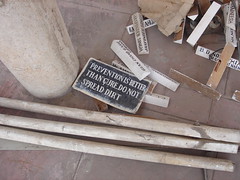Escape from Kathmandu is a book by Kim Stanley Robinson, which I saw constantly while in the city, and never read.
It's also something you'll want to do frequently while living and working in Kathmandu. The city has its share
of magic, but more than its share of air and noise pollution. The Mountain 'Du is a perfect example of how increased "prosperity" can actually made a place less liveable. An increasing number of personal vehicles on the road, paired with zero emissions laws and aggressive "horning" habits have turned the pagoda-filled valley into a smoggy cauldron. Increased political awareness and labour organization mean more frequent garbage strikes, with mini-Mount Trashmores accruing on every other corner. Negotiating the obstacle course of a Kathmandu street can provide great practice for rural trekking.
Fortunately, behind its traditional brick-masonry walls, Kathmandu hides a number of gracious courtyards where soothing fountains flow, sunlit gardens quietly thrive, and iced drinks are served in the shade. The "valley of Shangri-La" was thought to be a hidden paradise amongst craggy mountains; similarly, these urban oases offer respite from the grime.

1.
Hotel Shangri La Shambala Gardens: Along with the Yak and Yeti, Shangri-La is the old, established face of genteel higher-end Kathmandu tourism. The Shambala garden, designed by artist and Nepalophile the late Desmond Doig, serves Illy coffee imported from Italy and seemingly endless sunny days. Spotless white parasols provide shade on the lawn, or you can take refuge from the sun in the glassed-in terrace. The swimming pool is available to outsiders on weekends, and Shangri La's restaurant serves decent Indian, Nepali and continental food.
2. To step off noisy Gaushala (the name means "Cow shelter") and enter the gates of
Dwarika's heritage hotel is to truly experience another city within the city. Dwarika Das Shrestha devoted his life to collecting the intricate hand-carved wooden pieces being discarded by Kathmandu's modern property developers, not knowing what he'd ever do with them, but sensing their innate value. His hobby eventually became this hotel, which doubles as a museum for Newar art heritage. The complex manages to be enormous and intimate simultaneously, and each room feels individually appointed and hand-crafted.
Dwarika's is located rather out of the way, unless you are on your way to either Pashupatinath or the airport, but is well worth the taxi ride. As a true star hotel, Dwarika's offers no less than three restaurants - the main terrace with its adjoining (and icily air-conditioned Library Lounge), the Fusion bar and restaurant, (which serves a mean Lychee-flavoured frozen margarita), and Krishnarpam, where traditional Newar maharajah's meals ranging from six to twenty-two courses are served (must be ordered in advance). If you're on a budget, stick to the lemon cheesecake and the iced tea, which with its cinnamon-lemon-mint flavours, has to be some of the best in the world
3.
Kantipur Temple House is less illustrious than Dwarika's, but with its central Thamel location, far more convenient for most travelers. A stroll down the labyrinthine streets toward the neighborhood known as Jyatha will bring you to the courtyard of the Temple House, where you can easily alternate between the cool shade of the interior or the soothing sun of the gardens. KTH prides itself on being entirely eco-friendly, using no disposable plastics and furnished entirely with locally crafted products. It's perfect walking distance from both the busy Kantipath main road and the historic locations of Durbar Square, Hanuman Dhoka, Swayambhu and Ason Tol.
4. Garden of Dreams was concocted in the 1920s as a classic Victorian "folly" of Field Marshall Jung Bahadur "Kaiser" Shamsher (namesake of the neighborhood, Kaiser Mahal), during a phase in Nepali history when local rulers were smitten with European tastes and trends. The soi-disant "Kaiser" made mini-Versailles with pavillions and environments representing the six traditional Nepali seasons (
spring, summer, monsoon season, early autumn, late autumn, and winter). After his time the garden's gazebos, fountains, statues and cupolas fell into disrepair, and were recently (2006) restored by Goetz Hagmuller and the tireless Austrian team of art historians who also organized the Patan Museum. Though only three "seasons" could be saved (others having long since been demolished to make way for lucrative tourist properties), the Garden's tasteful blend of neo-classical, traditional Nepali, and modern features live up to the name. Entrance is 180NRs for foreigners or, for long-termers, a mere 2000Nrs for annual unlimited membership (about $30 US).
5.
Hotel Nirvana Garden is another pleasant surprise within Thamel, all the more so for its proximity to the hustle and the high-decibel rock music that pervades the area from 8pm to the wee hours. A lush garden with waterfall and noisy frog pond will soothe your traffic-shredded ears. It's located just round the corner down a backstreet from the world-famous Kathmandu Guest House.
A personal favourite (and round the corner from my flat) is the restaurant
Tushita (translation: place of contentment). The coffee is good, the food mediocre; but its traditional Brahmastanam architectural structure is uplifting and spacious, with plenty of cool corners to hide in, and free wi-fi. The real heart of Tushita is "Dai," a senior Newar gentleman unfailingly atted in flawless topi-daura-surwal, who performs Buddhist pujas daily in the lower courtyard. Tushita also has an unadvertised, small guest house with a loyal following in the garden behind the restaurant.
There are still more hidden gems -
Babar Mahal Revisited, Mike's Breakfast, Cafe Imago Dei, and the gardens of the sequestered
Hotel Vajra. Gritty on the surface, modern Kathmandu secretly retains the laid-back ways that made Nepal so popular with road-weary backpackers 1970s hippie overland days.



























